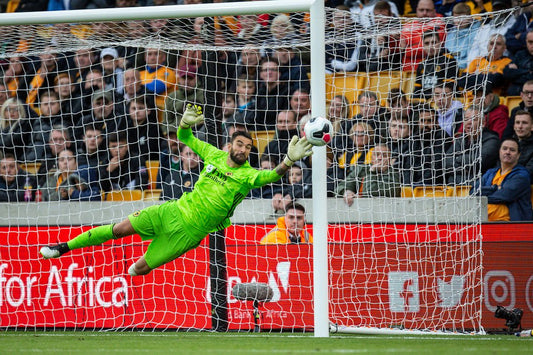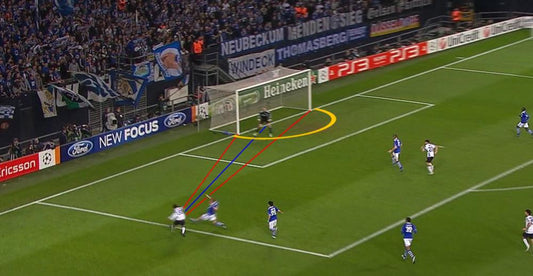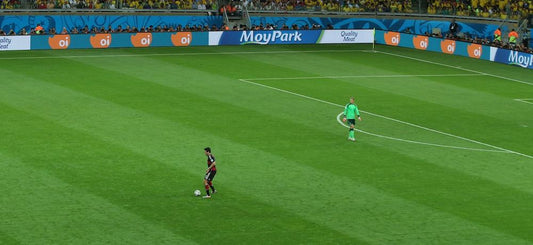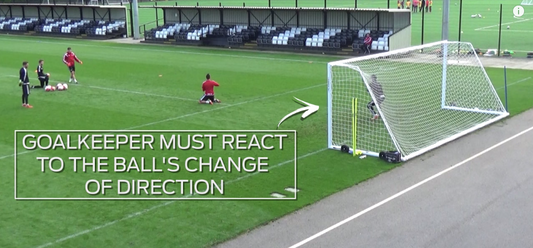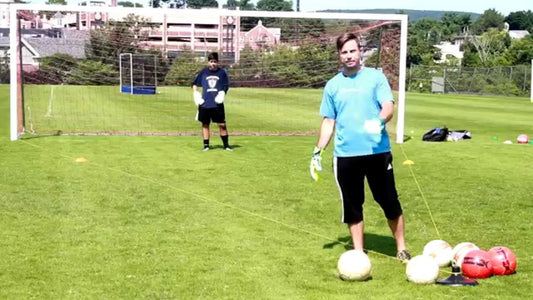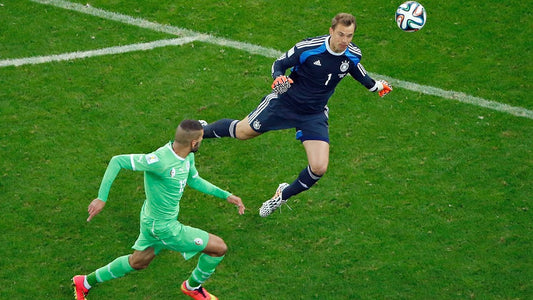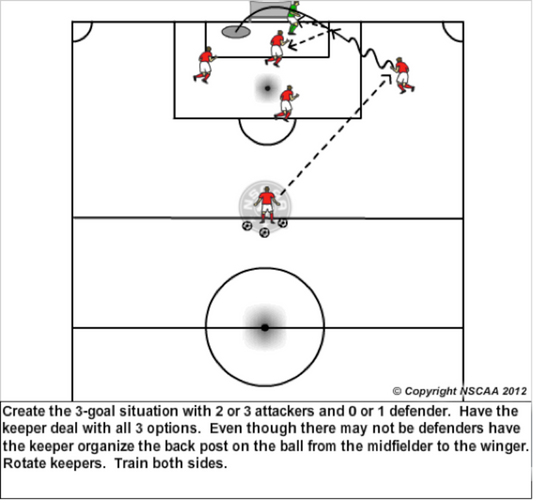Youth soccer goalies to professional goalkepeers work every day on being in the right position for a shot, cross, and free kick. Knowing where to stand and the proper angle is the difference between a save and goal.
Angles & Positioning
Angled Shot Stopping
Angled Shot Stopping – Key Elements
1. Footwork – short movements
2. Position – around ARC
3. Balance
4. Height in Set Position
5. Type of Save – Decision Making
6. Recovery Movement/Save
Use an imaginary ARC to get good start position.
ARC should only go to 3 yards off line.
Hold your ground and transfer pressure to the striker “make the striker beat you”
Advancing down the line only reduces reaction time and opens the goal if the ball is cut back or passed across the goal.
If the striker takes a bad touch or has head down and you can get close enough to ‘affect the ball’ (smother/block/steal) then use the opportunity at Speed and with Aggression.
Don’t sell yourself….
Andy Quy is the First Team GK Coach at Stoke City Football Club in the English Premier League. Andy coaches Bosnian International Asmir Begovic, Thomas Sorensen ex-Danish International, and Jack Butland, England U-21 GK & Team Captain. Coach Quy has worked hard to reach this level, previously working within Derby County and Aston Villas academy before moving on to work with Lincoln City and Stoke City First Teams prior. Andy has been with Stoke City since August 2007 and is now considered as one of the English Premier League’s leading goalkeeping coaches.
Coach Quy’s constantly developing coaching style is appreciated by all who work with him. With the younger goalkeeper, Andy believes that the basic skills must be well established alongside positional and tactical elements to give a sound foundation for all goalkeepers. Practices must be functional, game related and realistic. Coach Quy’s temperament and experience encourages the goalkeepers to express themselves and individualize their game. It is this style of coaching that has led him to such top levels of success.You can find out more by visiting 192sqft website to see their upcoming Summer camps in the US. Andy will be coaching alongside former Manchester United Goalkeeper Coach Eric Steele.
Goalkeeper positioning and where to stand are important to Angles.
Starting Stance
Before we address goalkeeper angles and positioning is it vital we begin with the proper body ready position.
The body and mind must be prepared to react. The body cannot be rooted to the ground. It needs to be in constant balance. Dynamic stability and balance is key. You are better off being out of position but in balance than being in position and off balance. The feet should be shoulder width apart, with the weight on the balls of the feet. The center of gravity is in a position of mobility. The palms of the hands are facing your body, showing 90 degrees of flexion at the elbow joint. The head is steady, with Shoulders Square to the ball. The body is in motion, to overcome the effects of inertia. This allows for a pre-stretch movement just prior to the shot. Concentration and total preparation are essential. First you establish your starting body position than with the knowledge you get into your saving position. Goalkeepers must be good dancers. There is fast and slow dance, big and small dance. Goalkeepers must be in the rhythm of the game to be good dancers. The ball is the goalkeeper primary partner as well as all the other factors that affect the goalkeepers position decisions.
Angle Play
Once the keeper has established good body position, good projection of one’s self, good dynamic stability, good balance and equal distribution of weight, it’s time to start talking about angle play. Angle play is three-dimensional. Keeper must be concerned with their left and right sides, the near post and far post. They also must be concerned with balls kicked above their heads. So positioning is three dimensional, left, right and above the head. Factors that influence how far the goalkeeper should come off the goal-line include the following: their physical dimensions, the speed that the attacker is coming toward the goal, the likely speed of the shot, the likely direction of the ball, the likely flight path of the ball, driven, rising, falling, or looping, and the condition of the field. First priority is to protect the near post. The ball has a shorter distance to travel and its speed will be greater. Remember, two hands to the near post, one hand to the far post. Experience will help g goalkeeper constantly evaluate all the factors mentioned above. Have the keeper create an imaginary line from the belly button to the ball. This is known as the ball line. When the ball is in motion, the goalkeeper is in motion. When the ball is stationary, the goalkeeper is stationary. The motion of the goalkeeper should be harmonious and in synch with the movements of the ball. The further the ball is from the goal, the further the keeper is form the goal line. The closer the ball to the goal, the closer the keeper is to his/her line. One of the best aids in helping the keeper visualize correct angle play is the rope. Tie each end of the rope to each of the posts and then stretch it out to the point where the ball lies. You move the ball and the rope and evaluate the keeper’s movements. The goal is, of course stationary and fixed in its dimensions. However, simply as a result of a goalkeepers accurate positioning, the goal can be made to appear to a shooter to be much smaller. It’s magical! When goalkeepers are in the right place at the right time, it’s not luck. It’s because they have mastered angle play.
If you were to line up soccer balls on the goal line from post to post. One row on top of the other, all the way up to the cross bar. How many balls would fit into the frame of a regulation goal? Ready, 364 soccer balls! Why is this important? If there is no goalkeeper in goal, there are 364 shooting pathways entering the goal. Once you add the goalkeeper you reduce the number of shooting entries and if the goalkeeper’s position is perfect you can reduce even more balls from entering the goal. The result, what the shooter perceives is based on the goalkeeper’s position. The goalkeeper can make the goal appear smaller with proper positioning and angle play.
Yours in Goal,
Dan Gaspar
About the Author: Dan Gaspar is the current Iranian National Team goalkeeper coach. Dan is also the founder of Star Goalkeeper Academy and director of Connecticut Soccer School. He was worked with Portuguese powerhouses Porto, Benfica, as well as Portuguese National Team. Coach Gaspar has also coached with the South African National Team and was the head coach of the University of Hartford. Dan has been a pioneer in goalkeeper education for more than 40 years.
To be the best soccer goalie you have to train with the best and be coached by the best. Check out the SGA goalkeeper camps summer schedule.
Controlling the Space Behind the Back Line
As the game evolves, so too must the goalkeepers’ role. Today's keepers are no longer confined to the goal area but are instead expected to play an active and integrated role throughout the game. As a result, a keepers' ability to meet the current demands of the position is determined in good measure by his or her ability to both understand and control the space behind the back line. To do this effectively involves not only supporting the play and preventing dangerous penetration of the defense, but also the ability to initiate and support the attack.
At the most basic level the foundation of skills needed for a goalkeeper to effectively control the space behind the back line is three fold and includes a tactical understanding of the game, the ability to move in all directions and the technical skill to handle a variety of balls without the use of the hands.
1) Tactical understanding of the game
To make appropriate decisions as to when and how to advance into the field to support the play and when to recover back to protect the goal, goalkeepers must understand what is happening in front of them. As well as determining the keepers positioning, understanding the game enables the goalkeeper to communicate tactical adjustments to the team. The ability to communicate these directions is essential in adjusting to, and preventing, dangerous situations from developing. While communication of this information may not directly go on a stat sheet, done correctly it has a significant impact on the goalkeepers’ presence on the field and how many and how dangerous scoring opportunities allowed during a game are.
2) Movement
It is the goalkeepers’ ability to move with varying pace in all directions and transition quickly between them that enable vertical and lateral movement into the field and recovery back to goal area. It is important to note that all keepers are not the same in this regard and the knowledge of one’s individual strengths and limitations and the ability to play within them is essential. A keeper who can move quickly into the field but has limited ability to move back becomes a liability if he or she does not understand this. Both Manuel Neuer and Tim Howard arguably excel at controlling the space behind the back line. However few would say that their play is the same. Instead each does so in ways that play to their individual strengths and abilities.
3) Technical ball skills
The ability to control and play the ball without the use of the hands is essential for today’s goalkeeper. Comfort with the ball allows a keeper to be utilized as part of the play both inside and outside of the box to prevent penetrating balls, relieve pressure on the defense and initiate the attack. While entertaining to watch most coaches today would not allow their keepers to roam the field as freely as Jorge Campos once did. However today's keeper must at a minimum be comfortable and confident in their ability to receive and play balls that are passed back, have the ability to intercept and control less predictable balls and put both appropriately back into play.
SUMMARY
It is the combination of tactical understanding, technical ball skills and physical movement ability that determines how each keeper moves within and controls the space behind the back line. The better this area is understood, and controlled, the more impact the goalkeeper has on initiating and supporting the teams attack, organizing play and transition and preventing dangerous penetration by the opponent. The goalkeeper who is able to do these things effectively can have a significant impact on the game and becomes a vital part of the team at all phases of play. Training today's keeper must therefore address all of these areas in multiple ways and on a consistent basis as an integrated part of training.
TRAINING SUGGESTIONS
Incorporate multi-directional movement – Vertical/Lateral/Angled
This can be done during both the warm-up and traditional training phase of a session.
Forward/Backward Run Shuffling - lateral and angled
Drop-step Crossover-step
Forward/Backward skips
Remember the ability to change between movement skills is essential and once the basic movement pattern is understood exercises should incorporate changes between footwork variations.
Integrate the goalkeeper(s) into training
When done properly this integration includes the keeper in the learning and training phase of tactical components of team play and allows for the understanding of team goals and individual player strengths, weaknesses and tendencies.
Sessions can also be set to encourage/require the keeper to develop comfort on and with the ball in general situations (i.e. possession play) and in functional situations such as receiving a back pass and re-starting the play. Keepers can be used in any number of ways outside the goal during a training session. For example they can be used as targets and must receive the ball without hands or in a possession game the ball must be played back to the keeper and restarted from them. Be creative, the more experience a keeper has in different situations the more adaptable they can be in a game.
Let them play and test their range
Encourage your keeper to experiment with and test his or her movement range and handling ability during training. Doing this will allow the keepers to both develop the confidence as well as the understanding of what they can effectively execute in a game.
Sarah Dwyer-Shick: DHC - Eastern NY Girls North ODP, NY Rush/Patriots Goalkeeper Coach
Soccer Goalie Drills for Developing Quick Reactions
These Soccer Goalie Drills for Developing Quick Reactions are an excellent way to help your goalkeeper improve speed, agility, awareness and confidence in goal. Here Christian Benjamin of Keeperstop, puts a High School Goalkeeper through a series of exercises to improve his overall performance in goal.
Click on this link to watch the Youtube Video of the Session.
Positioning and Angles: Where do I stand and where do I start?
If you’re not in the right place it can be difficult to make the save, if you are, the save becomes much easier.
I tell my keepers that you can have the best technique and be very athletic but if you are not in the right position when the ball is struck your chances drop dramatically of making the save. Conversely, you can come up big if you are in the right position.
Let’s start with a couple of terms and basic tenants:
Ball Line: The line from the center of the goal to the ball (fig. 1 dashed line). That line should run right through the center of your body.
Angle: This is the angle created when you draw a line from each goal post to the ball (fig. 1 red lines). You should be splitting this line down the middle. This line also shows you how much goal you are covering. The further off your line you play the smaller the width of the goal.
The ball line and splitting the angle are effectively the same thing, although your ball line does not show you the width of the goal based on your position forward and back.
Also, your position forward and back creates a vertical angle not often considered; that is the goal height in relationship to your positioning (fig. 2).
Given these considerations I recommend that you learn to play 2 to 3 yards off your line and adjust as needed from there. This gives you the best angle and ball line on a majority of shots in the penalty area.
“No mans land”: No man’s land is that area you avoid, this is a position that does not allow you an opportunity to save an arcing ball at the goal line or be close enough to the striker to influence their shot.
Often keepers find themselves here when they don’t close down a breakaway/through-ball fast enough or they are playing too aggressively off their line when the ball is in striking distance.
Balls on the flank :You should handle balls on the flank like a reflection in a mirror… the closer the ball is to the touch line and goal line the more central you can be in the box, once the ball starts moving into the 18 and into striking distance you start moving to cover near post (fig. 3).
Use caution here if you are on a non-regulation size field, many fields in youth soccer are far from regulation, making the touchline closer and more dangerous. I suggest that you ask yourself the question: “Am I in a good position to reach a service into the box and if they rip a near post shot from right there can I make the save?” if the answer is yes to both you are in the optimal position.
Balls at the top : Are handled similarly to balls on the flank. By this I mean in a “reflection in a mirror” fashion (see fig. 4), although the risk is greater here since the goal is bigger than when the ball is on the flank .
This also takes more skill in reading the play and letting that dictate your positioning. In general once the ball enters the attacking third you will tend to be closer to your line. When the ball moves into striking distance you will start to close down the angle without exposing yourself high. The question you ask here is “ am I in the best position for a driven ball (able to minimize the angle) and still able to get back to the bar on a chipped or flighted ball” if the answer is yes to both you are in the optimal position.
Positioning is also going to vary depending on your height and physical abilities (vertical jump, footwork. Etc.). You have heard the term “getting caught off your line”, that means the GK has probably been beaten high because they were too far out, beyond their ability to track back for the high save. But there is also as much or more risk in staying “married” to your line. When you camp on your line this makes the goal very large and scoring opportunities very easy for the opposing team.
SOME FINAL CONSIDERATIONS
Looking for opportunities: Your position should also put you in a location to easily get to flighted balls and get a jump on through-balls /breakaways. This requires you to read and understand what is happening in the game. Who has possession, how close are they to goal, do they have time and space, are they looking at one of their teammates for a run, are they looking at you to see where you are standing? All of these indicators may dictate minor adjustments in your position and stance to give you an edge at getting to a ball in the penalty area. This is beginning element of “controlling the box”. If you can shut down a play before it becomes dangerous you will make your job that much easier.
Flow of the Game.
You have an obligation to support your back line and be an option for redirection of play. This requires you to move up and out with the flow of the game. When the ball is in the opponents end under your teams control you should be out midway between the center circle and the top of the “D”.
You need to always be ready for long balls through and to help your team out of a foot race with a pass-back. Think of yourself as a shark patrolling the open water between you and your back line.
Last but not least…..
Reading the rhythm of the shooter: This is a skill that is critical to a goalkeeper, it takes lots of game time spent handling a variety of shots to learn when and how the shot will come.
Based on the rhythm of the shooter you may “step into” a driven shot, cutting the angle just a bit more. If you are expecting a flighted ball high to the cross bar or a chip reposition back a step (Do not cheat on a shot or cross, a good striker will make you pay for getting even slightly out of position).
A charging striker, under pressure, coming in with head down body over the ball will have a difficult time getting a chip off and will probably drive it. A striker outside the 18 with time and space and an upright body language looking to see your positioning may try to hit you high. These are not hard and fast rules but you can quickly gain a lot of info on the types of players in the game in a few short minutes.
The game is really where you develop and refine this skill. The more you play the more you understand what works and what doesn’t. I always say test and learn your range in practice and scrimmages; if you play conservatively in practice you will never learn the extent of your range or improve your range in a game.
Contact us with any questions !
Net Edge Training, LLC has been training Goalkeepers since 1999. We were the first to develop the Striker/Keeper format and have been doing the Striker/Keeper Series every summer since 2006. Below are the Series dates for 2009. Call us at 973-476-0611 Email us at g.goalkeepers@verizon.net Check the website for updated information www.netedgetraining.com
Elite Female Striker/Keeper Series™ July 27th to July31st @ FDU Teaneck in the afternoons. For High school and college bound keepers and strikers looking for intense, challenging sessions to get ready for preseason. Tentative, Check the web site for updates
MVP Striker/Keeper Series North July 27th to July 31st in the mornings. Morristown, NJ for players u10-U13 Boys and girls
MVP Striker/Keeper Series South in Mt Laurel, NJ dates TBD for players u10-U13 Boys and girls Elite Female Striker/Keeper Series™ in Virginia Beach, VA August 1st to August 5th. For high school and college bound keepers and strikers looking for intense, challenging sessions to get ready for preseason. Tentative, Check the web site for updates
How Far Off The Line Should The Goalkeeper Be?
Too often I see keepers camped out on their goal line while the play is going on in the other keeper’s box miles away. This leaves a giant space behind the defense for a dangerous long ball to be played.
A Detailed Look at the 3-Goal Situation
The opposing striker beats your left back on the flank, penetrates the 18 and he/she heads for the goal line with the ball. As a goalkeeper, what do you do? What are your priorities as far as positioning?

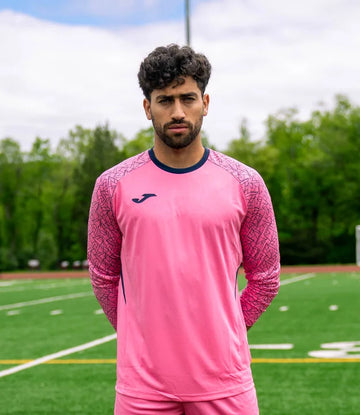
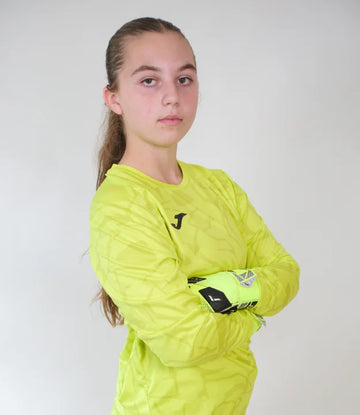
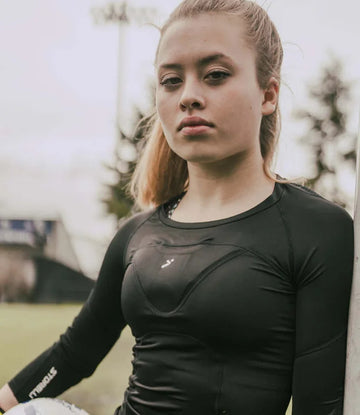
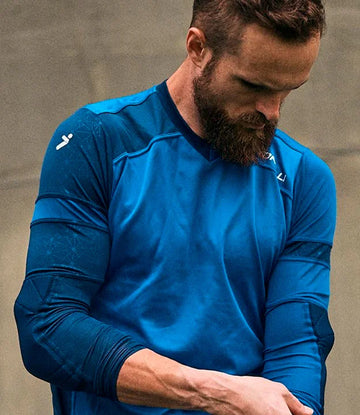
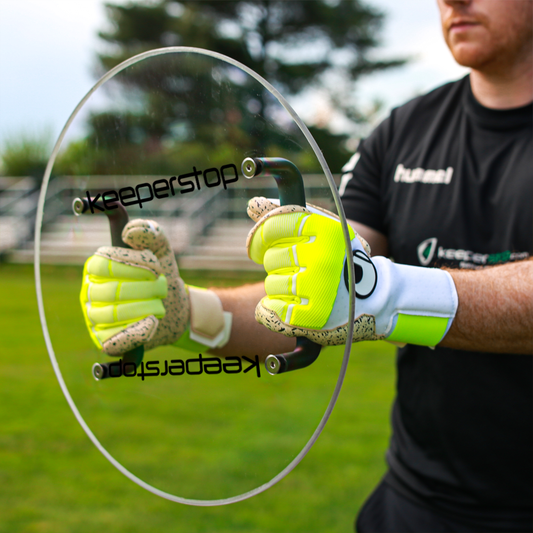
 Gloves
Gloves
 Jerseys
Jerseys
 Gear
Gear
 Brands
Brands
